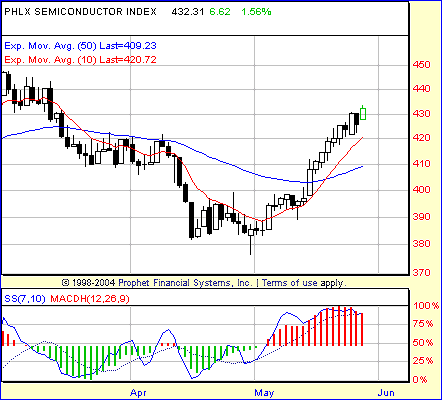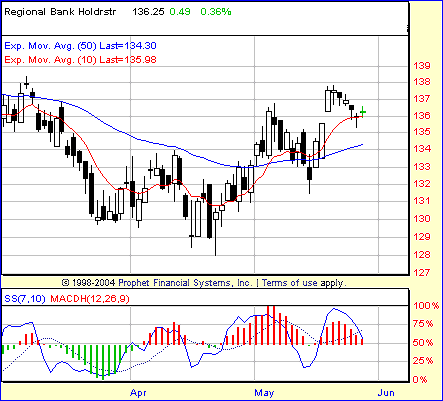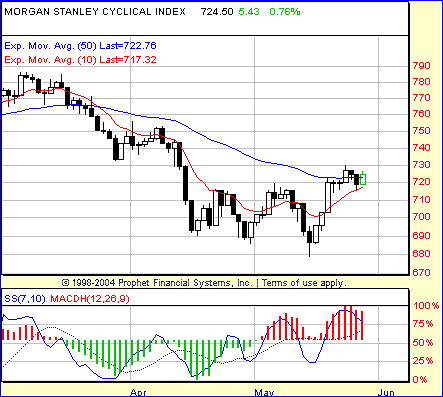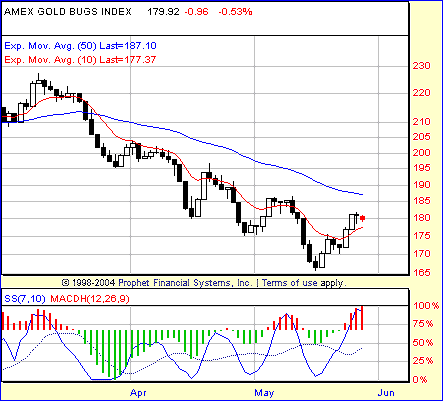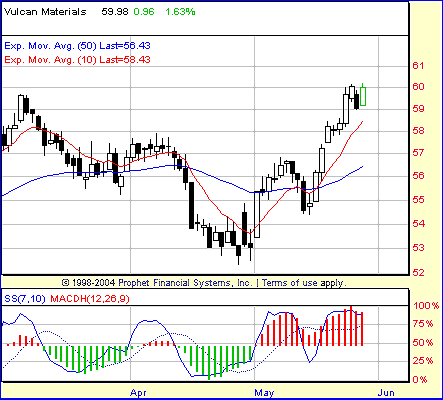
HOT TOPICS LIST
- Strategies
- Stocks
- Buy
- Investing
- Brokers
- Psychology
- Interviews
- Accumulate
- Sell
- Hold
- Spotlight
- Websites
- Candlestick Corner
- Gold & Metals
- Options Trading
LIST OF TOPICS
MARKET UPDATE
Weakness In Strength
06/01/05 11:25:53 AM PSTby David Penn
In times of peace, prepare for war.
| The market bottom is in, and all around us, people are counting coup on who was in for the bottom and who got left out. Never mind that many of those who were in for the bottom were also in for the entire ride down. The new fact of the matter is that the market is moving up, baby, and either you are in now or you are on the sidelines watching the profits go by. This is also where the temptation is greatest to chase those markets that are moving the farthest and the fastest away from that bottom. True enough, jumping on the bandwagon while it is still getting up to speed can be both exhilarating and profitable. And no doubt this truth — along with greed and the fear of being, to borrow a phrase, "left behind" — drives many people to pile into markets they might otherwise avoid. However, traders and technical analysts have other work they can do at this moment in the market's rise, work that can be done regardless of whether a given trader was in at the right time or able to buy a given pullback or sideways movement in a market that is otherwise moving higher at a quick rate. And while this work might not help the trader or technician take advantage of the opportunity at hand, it will surely better prepare him or her for the next opportunity to come. THE ART OF WAR One way to cull trading wisdom from Sun Tzu's advice for warriors and generals is to use good times to prepare for bad times. Given the fact that most people equate "good times" with rising stock values, the translation of Sun Tzu into trading-ese might read: "In bull markets, prepare for bear markets." But how does a trader prepare for bear markets — especially at a time when stock prices are rising, economists and financial pundits are universally optimistic, and everyone is wondering just how good things can get? It is a truism in the market — one favored by former hedge fund manager, founder of TheStreet.com, and current broadcast financial commentator, Jim Cramer — that there is always a bull market somewhere. I would add that the opposite is no less true: There is always a bear market somewhere. For example, during the great reflation of 2003, just about every asset class rose: bonds, stocks, gold, real estate. So where was the bear market? In the US dollar. There is an important distinction, however. In the case of the great reflation, so many asset groups were all moving higher because that movement was at the expense of the dollar. Within the galaxy of stocks, on the other hand, one sector's bull market is not necessarily the direct beneficiary of a bear market in the other. In fact, it is often the case in stocks that a sector that won't join in an otherwise broadly based advance will not only fail to rally strongly when that broad-based advance ends, but also, these previously lagging stocks that have been unable to move higher in a rising market will tend to fare even worse when the broad market trends reverse to the downside. TREND BUCKING And while this kind of analysis can be performed regardless of whether a given trader or technician has a bullish or bearish long-term view, there are potential benefits to knowing that — and trading as if — a bull or bear market is in effect. For example, it makes more sense to look for weakness in the strength of a bear market rally than it does to look for weakness in the strength of a bull market's typical upswing. Why? Because when weakness returns to the broader market in the bear market rally scenario, all stocks should be negatively affected, with the weaker ones during the bear market rally suffering the worst. Recent strength in the market provides an opportunity to test this theory. Over the past few weeks, the declines of March and April have been stemmed and a number of sectors have shown surprisingly strong moves to the upside. Among these are sectors such as tech, financials and retail. What I've done is set up my chart window so that only the period from late March through early June is visible. Then I scroll through a watchlist of about 36 different sector charts and look for divergences. In the time-window mentioned, most indexes, exchange-traded funds (ETFs) and sectors bottomed in April and by late May had taken out the previous month's high. Others that lagged bottomed early in May but were still on balance significantly higher by the end of the month.
Figure 1: Semiconductor stocks were among the first shares to show strength in spring 2005. The positive stochastic divergence over the second half of April was one clue that these stocks could move higher, near term.
Figure 2: Regional banking stocks have also performed well since putting in a mid-April bottom. Note the positive stochastic divergence between the March and April lows.
Conversely, stocks that have been underperforming during this period of generally rising stock markets have been commodity-oriented stocks: oil and gas, chemical companies, "smokestack" stocks, and the gold and silver mining shares.
Figure 3: Cyclical stocks have continued to struggle in late spring.
While the broader market is moving higher on the basis of strength from technology and the financials, the late-cycle stocks are either treading water or slipping slowly beneath the waves. Should the current advance in the market not turn out to be the beginning of a new bull market and, instead, we see many of today's leaders in technology and the financials begin to slip, then the late-cycle cyclical and smokestack stocks will be in danger of being truly pummelled in the ensuing decline. TAKING TOMORROW'S GAINS TODAY? Why is this important? Cyclical stocks like the industrial, chemical, and basic industry stocks tend to outperform late in the economic cycle. So the fact that these stocks appear to have topped out in the first few months of 2005 begs the question of whether the economic cycle has itself topped out, with a recession — softly landed or not — just around the corner. There's even another level of analysis that can be conducted based on the relative strength of the various sectors as expressed by stock price performance. While there is a great deal of concern about inflation discussed in the mainstream media, truly earnest inflationary expectations would result in weaker prices for bonds (which have been strong over the past few months) as well as firmer prices for many commodities — and their stocks. If, in fact, the smokestack and commodities stocks are in danger of dragging the market down into another bear swing — much as they led the rest of the market downward early in 2005 — then it is far less likely an inflationary near-term future and far more likely a deflationary near-term future that stocks in general and these stocks in specific may be anticipating. The perfect example of this is in the gold stocks, which have been in a bear market, really, since December 2003 (!) when the $HUI topped out near 260. The fact that gold stocks have been falling for a year and a half may argue against a strong, growing economy. But it would argue against the sort of inflation that such economies tend to generate, especially late in a given economic cycle.
Figure 4: Gold mining stocks have been in a bear market for almost a year and a half. How long-lived will any bounce in this sector be?
So are those accumulating technology and financial shares merely getting in early on the next upswing of the cycle — or will they be forced to ride the techs and financials down first, before enjoying their gains as the "early adopters" of any new bull market? That is one of the perennial questions of financial speculation and market timing — whether it is better to take the risk of being correct but early. In fact, given the growing divergences (both stochastic and from the moving average convergence/divergence histogram) in the indexes of the smokestack stocks and the gold stocks, there is an argument for bottom-feeding some of the stronger commodity names in hopes of a bounce induced by the broader markets' general bullishness. Examples of smokestack stocks that have outperformed their cohort and are actually trading above their intermediate-term moving averages include Air Products and Chemical (APD), Great Lakes Chemical (GLK), Valspar Corporation (VAL), and Vulcan Materials (VMC) (see Figure 5).
Figure 5: Vulcan Materials is one of the few "smokestack" stocks that has advanced appreciably since April.
And given the paltry returns on cash, the phenomenon of yield chasing that has pervaded markets such as fixed income, it may be hard to begrudge investors — or, at least the more speculative among them — from taking whatever gains they can, even if it is in the form of a momentum play on an overextended tech sector or an ultimately abortive rotation back into smokestack stocks — while those gains are there to be gotten.
David Penn may be reached at DPenn@Traders.com. Current and past articles from Working Money, The Investors' Magazine, can be found at Working-Money.com. |
Technical Writer for Technical Analysis of STOCKS & COMMODITIES magazine, Working-Money.com, and Traders.com Advantage.
| Title: | Traders.com Technical Writer |
| Company: | Technical Analysis, Inc. |
| Address: | 4757 California Avenue SW |
| Seattle, WA 98116 | |
| Phone # for sales: | 206 938 0570 |
| Fax: | 206 938 1307 |
| Website: | www.traders.com |
| E-mail address: | DPenn@traders.com |
Traders' Resource Links | |
| Charting the Stock Market: The Wyckoff Method -- Books | |
| Working-Money.com -- Online Trading Services | |
| Traders.com Advantage -- Online Trading Services | |
| Technical Analysis of Stocks & Commodities -- Publications and Newsletters | |
| Working Money, at Working-Money.com -- Publications and Newsletters | |
| Traders.com Advantage -- Publications and Newsletters | |
| Professional Traders Starter Kit -- Software | |
PRINT THIS ARTICLE

|

Request Information From Our Sponsors
- StockCharts.com, Inc.
- Candle Patterns
- Candlestick Charting Explained
- Intermarket Technical Analysis
- John Murphy on Chart Analysis
- John Murphy's Chart Pattern Recognition
- John Murphy's Market Message
- MurphyExplainsMarketAnalysis-Intermarket Analysis
- MurphyExplainsMarketAnalysis-Visual Analysis
- StockCharts.com
- Technical Analysis of the Financial Markets
- The Visual Investor
- VectorVest, Inc.
- Executive Premier Workshop
- One-Day Options Course
- OptionsPro
- Retirement Income Workshop
- Sure-Fire Trading Systems (VectorVest, Inc.)
- Trading as a Business Workshop
- VectorVest 7 EOD
- VectorVest 7 RealTime/IntraDay
- VectorVest AutoTester
- VectorVest Educational Services
- VectorVest OnLine
- VectorVest Options Analyzer
- VectorVest ProGraphics v6.0
- VectorVest ProTrader 7
- VectorVest RealTime Derby Tool
- VectorVest Simulator
- VectorVest Variator
- VectorVest Watchdog

